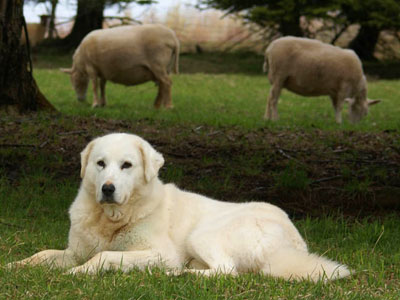
The Akbash Dog - General Breed Description
HISTORY: Akbash Dogs are an ancient breed used for centuries to guard livestock in Asia Minor, now known as Turkey. They appear to have both sighthound and mastiff influence in their ancestry. Their own ancestors may well be the progenitors of similar breeds such as the Great Pyrenees, Kuvasz and Maremma.
SIZE AND DESCRIPTION: The Akbash Dog is a large, all-white dog with dark eyes, nose and skin pigment. These dogs have a keen sense of sight, hearing and smell, are tall, long-bodied and long-legged, and can run with amazing speed. Females range in weight from 75 to 105 pounds, and are 27 to 30 inches at the shoulder. Males are generally between 95 to 125 pounds and 28 to 32 inches tall. The Akbash Dog is slow to mature and males may not reach full size until the age of three or more. Bitches over 110 pounds and males over 130 pounds are usually overweight. They are supposed to be lean, tall dogs with ribs just visible as they move.
COAT TYPE: There are two major coat types and variations in between; a medium coat is one to three inches long, and a long coat that can be identified by the six to eight inch mane and tail feathers. Both types have a coarse outer coat that does not easily matt, and a softer, shorter undercoat. Coats, primarily the undercoats, are shed in warmer weather. In cold weather both medium and long-haired dogs grow thick undercoats to keep them warm in the most bitter continental climate.
INTELLIGENCE: Akbash Dogs learn quickly, however they are easily bored with repetitive obedience training exercises so they are not ideal candidates for obedience competition. They will respond best to people they respect, and that respect must be earned by treating them with fairness and consistency and establishing a hierarchy with people at the head. They are clever when motivated, and can learn how to escape poorly fenced areas if they are bored or feel they must investigate activities on the other side.
ENERGY: (Medium, Low) Akbash Dogs tend to be calm, with a low rate of metabolism. A quiet temperament makes this breed acceptable to the stock they guard. As pups they are more active and do require daily exercise. If they have no outlet for physical exercise, they will channel their energy into destructive behavior such as barking, digging, pacing, chewing, escaping. They must be well fenced or they will leave the property to guard or investigate other animals, people, activities. They should never be chained for any length of time.
BEHAVIOR: Males and females alike possess a strong maternal instinct, especially with respect to small and young animals and children. They bond to whatever they are raised with, which is why it is suggested that as pups they be placed with the livestock they will eventually be expected to protect. A pup will not usually be dependable until it is about twelve to eighteen months of age or older, although some exceptional dogs are working seriously at six months.
Akbash Dogs have also fulfilled the role of companion dogs, although that is not usually advised unless owners have had previous experience with a large breed, particularly of the guard dog variety. Livestock protection breeds are noted for their independence, which necessitates firm, consistent handling and discipline from a very young age. They love to work, however, and as long as they understand what is required of them, they will perform with great dedication. They must be kept in a well-fenced area, especially in areas with other dogs, people and vehicular traffic. They tend to be aggressive towards strange canines and sometimes other species such as stray cats or trespassing strangers. Companion Akbash Dogs must be thoroughly socialized from a very early age, and continually socialized throughout their lives.
MOST COMMON AILMENTS: Generally a healthy breed, the following conditions can occur: hip dysplasia, gastric torsion (bloat), epilepsy, cruciate ligament injuries, hypothyroidism, umbilical hernias, cardiomyopathy, osteosarcoma, lymphoma and other cancers, kidney failure. Some of these conditions can be influenced by environmental (and nutritional) factors. All breeding stock should have hips certified free of hip dysplasia.
Buyers should investigate the health and temperamental soundness of parents and ask for a guarantee of sound temperament and working ability. Reputable breeders will provide their buyers with accurate and complete information before the sale, and will support them throughout the life of the dogs they sell.
